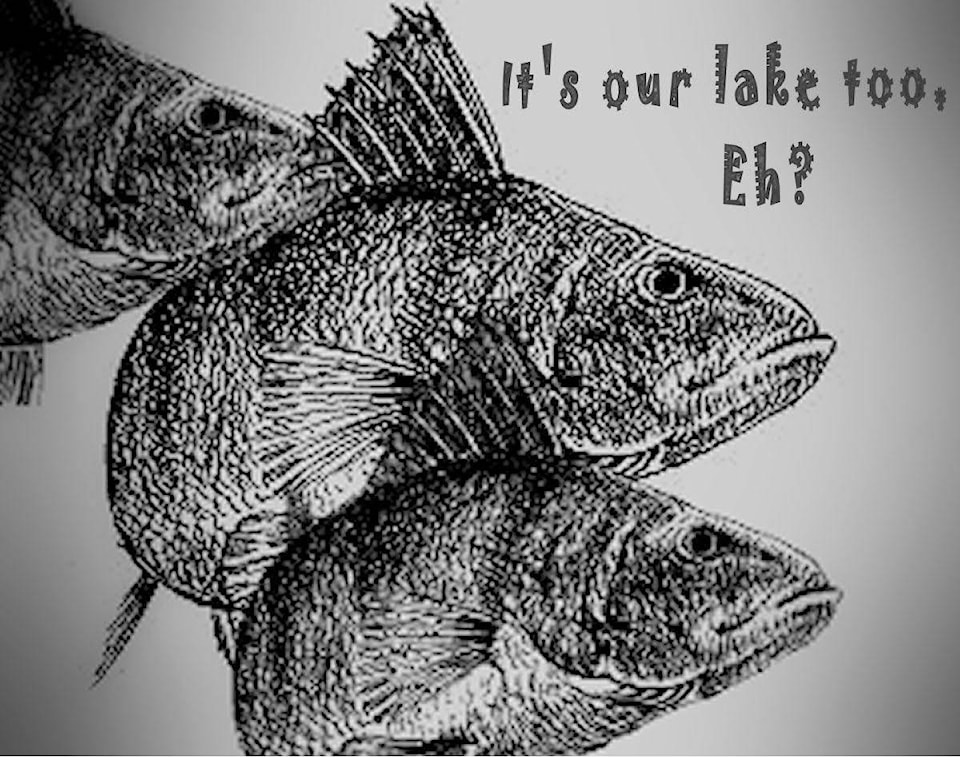If a walleye has survived from the sport fish stocking project of 1926, fishermen should be aware of a 93 years old senior citizen walleye lurking in Sylvan Lake. That is how long the lake fishery has been managed by the predecessor agencies and biologists of today’s Alberta Environment and Parks (AEP).
Fishing is normally not thought of as a focus of a stewardship group – after all, it is difficult to herd fish or recruit them as members of an organization. However, every healthy lake does have productive aquatic populations of fish who are never consulted. Let’s see what we know about them, and what can be done to maintain the sport fishery. This article is the sixth in the series by the SLWSS on aspects of stewardship of the watershed.
If fish could talk, they would likely make these points: Their aquatic habitats and neighborhoods have been deteriorating for years. Their friends have been disappearing. They have been forced onto a nutrient-lite diet. When they look out of the water from near-shore habitats at the nearby shoreline they see man-made impairment.
For background on those topics, the excellent online AEP Fish and Wildlife Internet Mapping Tool is the place to go for database facts on the Sylvan Lake fishery. A comprehensive 2018 presentation by Senior Fisheries Biologist, Jason Cooper, and Provincial Fisheries Scientist, Michael Sullivan provided an expert briefing on the fisheries management objectives for Sylvan Lake for this year. The Sylvan Lake News reported on it on April 19 last year.
Sylvan Lake surveys over three decades have reported a decline in fish abundance, and one only needs to look at the shorelines to note a loss in overall fish habitat. The current Fish Sustainability Index (FSI) for both walleye and northern pike classifies the habitat protection need as High. As both are important for recreational sport fishing these species are actively managed by AEP. The primary changes that have affected fishery habitat over time are: Two spawning wetlands, one that discharged Golf Course Creek into the lake and the other that connected the outlet flow through Sylvan Creek to Cygnet Lake, were developed without compensation. Fish can no longer freely swim between the lakes. Also, lake-lot shoreline development has had a cumulative impact.
Over the last decade 1,325,531 small walleye fry from the Cold Lake hatchery have been released into Sylvan Lake in an attempt to create a self-sustaining population. The AEP fishery management goal is a sustainable harvest over summer and winter seasons. Yet indicator catch-rate data from the AEP test- netting projects show that the stock of walleye is depleted. The FSI Adult Density scores for mature walleye have remained at high or very high risk since 2008.
Northern pike are also at risk in Sylvan Lake. The FSI Adult Density scores for mature pike have remained at very high risk during the last decade. In contrast, Lake Whitefish are relatively abundant with a catch rate signifying a Moderate to Low risk to that species population.
Evidence in the fishery scientific literature shows that results from a combination of fishing regulations and fish stocking campaigns have been mixed, and sometimes transient. Well-intended and theoretically sound intervention doesn’t always work as expected. Attempts to improve reproductive potential and spawning success of species, growth and survival of young fish into the size range attractive to anglers, while still permitting the harvest of trophy-size fish depend on many factors that are not within the control of fishery biologists.
The Alberta Fish and Game Association continues to support AEP fishery management goals with lobbying efforts on behalf of the sport fishing community. Healthy populations of walleye and northern pike are important to Alberta recreation. For those reasons the interactions between land use and lake water quality, and the human impacts on the aquatic protected areas are important. That means best stewardship practices come into play.
One question unresolved by fishery and lake scientists is the relationship between fish population health and the eutrophic classification of lakes. We know that Sylvan Lake has become oligotrophic as the nutrient concentrations have dropped in recent years for a variety of reasons. While that gives us nice, clear, algal-bloom-free water, it also reduces the biomass in the lake that is the food chain that sustains the fishery. The key indicator is the chlorophyll-a concentration, the green pigment and catalyst in plants that helps to convert solar energy and lake nutrients into food supply.
Does a clear, algae-free lake mean fish are on a forced weight-watchers diet and that low population densities measured by FSI scores mean absentee species? Time will tell.
The Sylvan Lake shoreline from the perspective of fish has changed, just like aquatic habitat has. Assessments by helicopter and drone video surveys by AEP have recorded that much of the populated riparian zone of the lake is impaired. Do fish care about fun-loving people on manicured lawns, their shoreline structures, and their docks and boats? In a spirit of reciprocity, they likely do not. However, assume that the cumulative effect of shoreline modifications and alteration of fish, and waterfowl, habitat is not helpful and that the 93-year-old walleye is watching.
